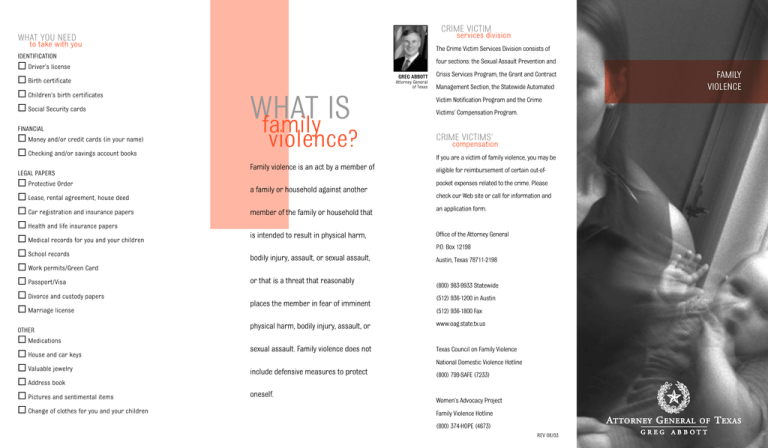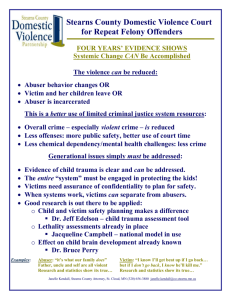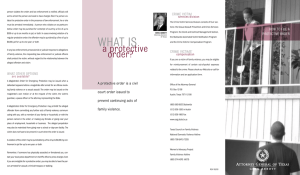
CRIME VICTIM
services division
WHAT YOU NEED
to take with you
The Crime Victim Services Division consists of
IDENTIFICATION
Driver’s license
four sections: the Sexual Assault Prevention and
Birth certificate
Children’s birth certificates
Social Security cards
FINANCIAL
Money and/or credit cards (in your name)
Checking and/or savings account books
LEGAL PAPERS
Protective Order
WHAT
IS
family
violence?
Crisis Services Program, the Grant and Contract
Management Section, the Statewide Automated
Victim Notification Program and the Crime
Victims’ Compensation Program.
CRIME VICTIMS’
compensation
If you are a victim of family violence, you may be
Family violence is an act by a member of
a family or household against another
Lease, rental agreement, house deed
Car registration and insurance papers
GREG ABBOTT
Attorney General
of Texas
eligible for reimbursement of certain out-ofpocket expenses related to the crime. Please
check our Web site or call for information and
member of the family or household that
an application form.
is intended to result in physical harm,
Office of the Attorney General
Health and life insurance papers
Medical records for you and your children
P.O. Box 12198
School records
bodily injury, assault, or sexual assault,
Austin, Texas 78711-2198
Work permits/Green Card
Passport/Visa
Divorce and custody papers
Marriage license
OTHER
Medications
House and car keys
or that is a threat that reasonably
places the member in fear of imminent
(800) 983-9933 Statewide
(512) 936-1200 in Austin
(512) 936-1800 Fax
physical harm, bodily injury, assault, or
www.oag.state.tx.us
sexual assault. Family violence does not
Texas Council on Family Violence
National Domestic Violence Hotline
Valuable jewelry
include defensive measures to protect
(800) 799-SAFE (7233)
Address book
Pictures and sentimental items
Change of clothes for you and your children
oneself.
Women’s Advocacy Project
Family Violence Hotline
(800) 374-HOPE (4673)
REV 08/03
FAMILY
VIOLENCE
A PERSONAL
a personal
SAFETY PLAN
safety plan
• Devise a code word to use with your children, family,
friends and neighbors when you need the police.
• Decide and plan where you will go if you ever have to
leave home.
Remember: You Do Not Deserve to be Hit or Threatened
GET A
FEELING SAFE
• If you or your children have been threatened or
• Decide whom you will inform at work of your situa-
protective order
assaulted, you can request a Protective Order from
tion. Tell the building security officers, and if possi-
your local district or county attorney.
ble, provide them with a picture of your batterer.
• Always keep your Protective Order with you.
• Call the police if your abuser violates the Protective
WHEN YOU ARE
preparing to leave
• Open a checking account or savings account in your
own name.
• Leave money, an extra set of keys, copies of important documents, and extra clothes and medicines in a
on the job and in public places
Order.
• Inform family members, friends, schools and neighbors that you have a Protective Order in effect.
• Think of alternative ways to keep safe if the police do
not respond immediately.
• When at work, if possible, have someone screen your
telephone calls.
• Have someone escort you to and from your car, bus
or train.
• Use a variety of routes to come and go from home.
IMPORTANT
phone numbers
safe place or with someone you trust.
• Get your own post office box.
DURING
an explosive incident...
• If there is an argument, try to be in a place that has
an exit. Avoid the bathroom, kitchen or any room that
may contain weapons.
• Use your instincts and judgment. In a dangerous
situation, appease the abuser if possible to keep him
or her calm.
• Practice getting out of your home safely. Identify
which doors, windows, elevator or stairwell to use.
• Find a safe place where you and your children can go
or a person who can lend you money.
• Always keep the shelter phone number and some
change or a calling card with you for emergency
phone calls.
• If you have pets, make arrangements for them to be
cared for in a safe place.
Remember: Leaving Your Batterer is the Time to be
Most Cautious
FEELING SAFE
Name and phone number of Shelter:
• If you stay in your home, lock your windows and
________________________________________________
in your own home
change the locks on your doors.
• Develop a safety plan with your children for when you
are not with them.
• Inform your child’s school, day-care, etc., about who
has permission to pick up your child.
relative’s house.
• Identify one or more neighbors whom you can tell
about the violence, and ask them to call the police if
they hear a disturbance coming from your home.
________________________________________________
Law Enforcement Liaison phone number:
________________________________________________
• Inform your neighbors and the landlord that your
partner no longer lives with you and that they should
District Attorney Victim Assistance Coordinator:
call the police if they see him/her near your home.
________________________________________________
• Never call the abuser from your home; he/she may
• Pack a bag and have it ready at a friend’s or
Name and phone number of Hospital:
find out where you live. Never tell the abuser where
you live.
• Request an unlisted/unpublished number from the
telephone company.








